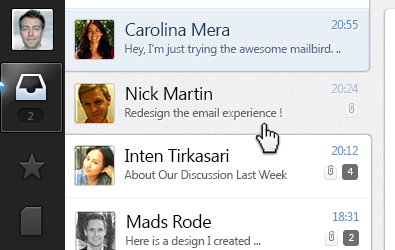Mailbird, a very Sparrow-like email client for Windows users, is launching into beta this week with plans to take its email desktop app beyond where Sparrow left off before being acquired by Google last July. The similarity between the two clients is striking, but co-founder and CEO Andrea Loubier insists that Mailbird isn’t copying Sparrow – it’s using that mail client’s look and feel for inspirational purposes only. And those similarities are only skin deep.
 “By no means are we copying Sparrow,” says Loubier of the two apps’ differences, besides the fact that one is for Mac and iOS users, while the other is for Windows. “What we’re using right now – it’s not like it’s something that only Sparrow did,” she adds. “It’s what we’re seeing as a trend in app design right now.
“By no means are we copying Sparrow,” says Loubier of the two apps’ differences, besides the fact that one is for Mac and iOS users, while the other is for Windows. “What we’re using right now – it’s not like it’s something that only Sparrow did,” she adds. “It’s what we’re seeing as a trend in app design right now.
“We looked at different apps that have this modern, flat design and went with those. They’re not exactly identical,” Loubier notes.
To the layperson who’s not a regular Sparrow user, the differences might be harder to spot, of course. And now that Sparrow is Google-owned, it’s unclear to what extent Sparrow’s new owners will have an issue with the user interface inspiration. However, given that the app is starting off with support for Gmail and Google Apps on Windows computers, Mailbird will probably get the chance to fly.
Though it was important to address the look-alike issue out of the gate here, the differences between Sparrow today and Mailbird don’t extend much further than that. Under the hood, Mailbird is working to bring some unique features to desktop mail clients, the most notable of which is an email app store. The company will open source that part of its code on GitHub, allowing third-party developers the ability to build their own integrated experiences into Mailbird itself.
The Mailbird team has already written some integrations of its own – not full email apps, but extensions – for Google Calendar and Dropbox to start. “The idea is that you can access everything from your email application, rather than have to navigate outside of it,” Loubier explains. “It’s like a one-stop shop in that sense.”
Mailbird also supports more advanced features, such as shortcuts, for those who want them. In fact, it supports the same shortcuts found in Gmail today, and will also allow users to customize their own shortcuts for things like compose or inline replies, for example.
“That’s the thing about the app – it’s super lightweight and simple, but there’s a lot of deep functionality about it,” Loubier says.
 Another idea on the roadmap is a plan to include an email dashboard called “Wingman,” which would show users how productive they’re being within their email (or, perhaps, the opposite) with stats for how long you spend composing messages, turnaround time for replies, who you email the most, and more. (That sounds inspired by Google’s own Account Activity Report or Gmail Meter, actually).
Another idea on the roadmap is a plan to include an email dashboard called “Wingman,” which would show users how productive they’re being within their email (or, perhaps, the opposite) with stats for how long you spend composing messages, turnaround time for replies, who you email the most, and more. (That sounds inspired by Google’s own Account Activity Report or Gmail Meter, actually).
And Mailbird will move to support multiple accounts in the future, too. For now, though, it supports a “send as” multi-identity feature for Gmail, Google Apps, Yahoo and Hotmail/Outlook.com.
Mailbird is currently based out of Bali, where’s it’s hosted under the incubator Contenga International, following Mailbird co-founder Michael Bodekaer’s Bali-based startup event, Project Getaway. Bodekaer has invested in the startup, but other than that, Mailbird is entirely boostrapped.
TechCrunch readers can gain early access ahead of this week’s official debut, as well as access to the Pro version for free for six months, which will include more features in the future. (Pro pricing is $12/year/user, will remove ads, and include “Wingman,” multi-identity and more; Business accounts with five-plus users will be $9/year/user). The sign-up is here: http://www.getmailbird.com/signup/?ref=techcrunch.
Mailbird works on Windows XP, Vista, 7 and Windows 8 (desktop not tablet). Plans to extend to other platforms – yes, including Mac – are in the works.
